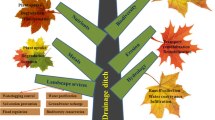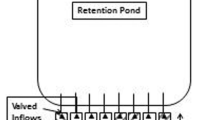Abstract
Feeding a growing population requires striking a balance between increasing production and decreasing environmental impacts in agricultural settings. We established 12 experimental mesocosms with silt loam atop a base of sand and examined the ability of three emergent aquatic plants common to the USA to remediate pesticides and nutrients in agricultural runoff. Mesocosms were planted in monocultures of Myriophyllum aquaticum, Polygonum amphibium, and Typha latifolia, or left unvegetated to serve as controls. All mesocosms were amended with target concentrations of 10 mg L−1 (each) nitrate, ammonium, and orthophosphate; 20 μg L−1 (each) of the pesticides propanil and clomazone; and 10 μg L−1 of the pesticide cyfluthrin. After a 6-h-simulated agricultural runoff with amended water, mesocosms sat idle for 48 h before flushing with unamended water for another 6 h. Outflow water samples were collected and analyzed for contaminant concentrations. Most significant differences between vegetated mesocosms and controls occurred when comparing mean contaminant transfer/transformation rates post-amendment. Differences among plant species occurred regarding retention of dissolved nutrients orthophosphate, ammonium, and nitrate. Similarly, all three plant species retained more propanil than controls during post-amendment (8–48 h), but individual plant differences occurred with regard to clomazone and cyfluthrin retention. While variation in mitigation of specific dissolved components of nutrients suggests different mechanisms involved in nutrient cycling within our mesocosms, consistent overall total nutrient and pesticide reduction during the post-amendment period indicate that holding runoff in vegetated ditches may reduce transport of agricultural contaminants to downstream aquatic ecosystems.

Similar content being viewed by others
References
American Public Health Association (APHA). (2005). Standard Methods for the Examination of Water and Wastewater (21st ed.). DC: Washington.
Brogan III, W. R., & Relyea, R. A. (2014). A new mechanism of macrophyte mitigation: how submerged plants reduce malathion’s acute toxicity to aquatic animals. Chemosphere, 108, 405–410.
Brogan III, W. R., & Relyea, R. A. (2017). Multiple mitigation mechanisms: Effects of submerged plants on the toxicity of nine insecticides to aquatic animals. Environmental Pollution, 220, 688–695.
Casjens, H. (2002). Environmental fate of cyfluthrin. www.cdpr.ca.gov.
Castaldelli, G., Aschonitis, V., Vincenzi, F., Fano, E. A., & Soana, E. (2018). The effect of water velocity on nitrate removal in vegetated waterways. Journal of Environmental Management, 215, 230–238.
Chapman, P. M. (2012). Management of coastal lagoons under climate change. Estuarine,Coastal and Shelf Science, 110, 32–35.
Chapman, P. M. (2018). Negatives and positives: Contaminants and other stressors in aquatic ecosystems. Bulletin of Environmental Contamination and Toxicology, 100, 3–7.
Christopher, S. H., Tank, J. L., Mahl, U. H., Yen, H., Arnold, J. G., Trentman, M. T., Sowa, S. P., Herbert, M. E., Ross, J. A., White, M. J., & Royer, T. V. (2017). Modeling nutrient removal using watershed-scale implementation of the two-stage ditch. Ecological Engineering, 108, 358–369.
Colmer, T. D., & Pedersen, O. (2008). Underwater photosynthesis and respiration in leaves of submerged wetland plants: Gas films improve CO2 and O2 exchange. New Phytologist, 177, 918–926.
Danchour, A., Bitton, G., Coste, C. M., & Bastide, J. (1986). Degradation of the herbicide propanil in distilled water. Bulletin of Environmental Contamination and Toxicology, 36, 556–562.
Heathwaite, A. L. (2010). Multiple stressors on water availability at global to catchment scales: understanding human impact on nutrient cycles to protect water quality and water availability in the long term. Freshwater Biology, 55, 241–257.
Imfeld, G., Braeckevelt, M., Kuschk, P., & Richnow, H. H. (2009). Monitoring and assessing processes of organic chemicals removal in constructed wetlands. Chemosphere, 74, 349–362.
Kasak, K., Kill, K., Pärn, J., & Mander, Ü. (2018). Efficiency of a newly established in-stream constructed wetland treating diffuse agricultural pollution. Ecological Engineering, 119, 1–7.
Kumwimba, M. N., Meng, F., Iseyemi, O. O., Moore, M. T., Zhu, B., Tao, W., Liang, T. J., & Ilunga, L. (2018). Removal of non-point source pollutants from domestic sewage and agricultural runoff by vegetated drainage ditches (VDDs): design, mechanism, management strategies, and future directions. Science of the Total Environment, 639, 742–759.
Lu, B., Xu, Z., Li, J., & Chai, X. (2018). Removal of water nutrients by different aquatic plant species: an alternative way to remediate polluted rural rivers. Ecological Engineering, 110, 18–26.
Meals, D. W., Dressing, S. A., & Davenport, T. A. (2010). Time lag in response to best management practices: a review. Journal of Environmental Quality, 39, 85–96.
Messer, T. L., Burchell, M. R., Bӧhlke, J. K., & Tobias, C. R. (2017). Tracking the fate of nitrate through pulse-flow wetlands: a mesocosm scale 15N enrichment tracer study. Ecological Engineering, 106, 597–608.
Moore, M. T., & Krӧger, R. (2011). Evaluating plant species-specific contributions to nutrient mitigation in drainage ditch mesocosms. Water Air Soil Pollution, 217, 445–454.
Moore, M. T., Bennett, E. R., Cooper, C. M., Smith Jr., S., Shields Jr., F. D., Milam, C. D., & Farris, J. L. (2001). Transport and fate of atrazine and lambda-cyhalothrin in an agricultural drainage ditch in the Mississippi Delta, USA. Agriculture, Ecosystems and Environment, 87, 309–314.
Moore, M. T., Denton, D. L., Cooper, C. M., Wrysinski, J., Miller, J. L., Reece, K., Crane, D., & Robins, P. (2008). Mitigation assessment of vegetated drainage ditches for collecting irrigation runoff in California. Journal of Environmental Quality, 37, 486–493.
Moore, M. T., Krӧger, R., Locke, M. A., Tyler, H. L., & Cooper, C. M. (2013). Seasonal and interspecific nutrient mitigation comparisons of three emergent aquatic macrophytes. Bioremediation Journal, 17(3), 148–158.
Partridge, J. W. (2001). Biological flora of the British Isles: Persicaria amphibia (L.) Gray (Polygonum amphibium L.). Journal of Ecology, 89, 487–501.
Pilon-Smits, E. (2005). Phytoremediation. Annual Review of Plant Biology, 56, 15–39.
R Core Team. (2017). R: A language and environment for statistical computing. Vienna: R Foundation for Statistical Computing. https://www.R-project.org. Accessed 27 Feb 2020.
Sinha, E., Michalak, A. M., & Balaji, V. (2017). Eutrophication will increase during the 21st century as a result of precipitation changes. Science, 357, 405–408.
Smith Jr., S., & Cooper, C. M. (2004). Pesticides in shallow groundwater and lake water in the Mississippi Delta MSEA. In M. Nett, M. A. Locke, & D. Pennington (Eds.), Water Quality Assessments in the Mississippi Delta: Regional Solutions, National Scope. ACS Symposium Series 877 (pp. 91–103). Oxford University Press.
Smith Jr., S., Cooper, C. M., Lizotte Jr., R. E., Locke, M. A., & Knight, S. S. (2007). Pesticides in lake water in the Beasley Lake watershed, 1998–2005. International Journal of Ecology and Environmental Science, 33, 61–71.
Soana, E., Balestrini, R., Vincenzi, F., Bartoli, M., & Castaldelli, G. (2017). Mitigation of nitrogen pollution in vegetated ditches fed by nitrate-rich spring waters. Agriculture, Ecosystems and Environment, 243, 74–82.
Taylor, J. M., Moore, M. T., & Scott, J. T. (2015). Contrasting nutrient mitigation and denitrification potential of agricultural drainage environments with different emergent aquatic macrophytes. Journal of Environmental Quality, 44, 1304–1314.
Tomer, M. D., & Burkhart, M. R. (2003). Long-term effects of nitrogen fertilizer use on ground water nitrate in two small watersheds. Journal of Environmental Quality, 32, 2158–2171.
United Nations. (2019). World population prospects 2017. https://population.un.org/wpp/. Accessed 15 Dec 2019
United States Department of Agriculture, Agricultural Research Service (USDA ARS). (1995). Pesticide properties database: Propanil. https://www.ars.usda.gov/ARSUserFiles/00000000/DatabaseFiles/PesticidePropertiesDatabase/IndividualPesticideFiles/PROPANIL.TXT. Accessed 27 Feb 2020.
United States Environmental Protection Agency (USEPA). (2019). https://www.epa.gov/ms-htf/northern-gulf-mexico-hypoxic-zone. Accessed 15 Dec 2019.
Van Meter, K. J., Van Cappellen, P., & Basu, N. B. (2018). Legacy nitrogen may prevent achievement of water quality goals in the Gulf of Mexico. Science, 360, 427–430.
Van Scoy, A. R., & Tjeerdema, R. S. (2014). Environmental fate and toxicology of clomazone. Reviews of Environmental Contamination and Toxicology, 229, 35–49.
Vero, S. E., Basu, N. B., Van Meter, K., Richards, K. G., Mellander, P. E., Healy, M. G., & Fenton, O. (2018). Review: the environmental status and implications of the nitrate time lag in Europe and North America. Hydrogeology Journal, 26, 7–22.
Vymazal, J., & Březubivá, T. D. (2018). Removal of nutrients, organics and suspended solids in vegetated agricultural drainage ditch. Ecological Engineering, 118, 97–103.
World Bank. (2016). Agricultural land (% of land area). https://data.worldbank.org/indicator/AG.LND.AGRI.ZS. Accessed 27 Feb 2020.
Yin, J., Gentine, P., Zhou, S., Sullivan, S. C., Wang, R., Zhang, Y., & Guo, S. (2018). Large. increase in global storm runoff extremes driven by climate and anthropogenic changes. Nature Communications, 9, 4389. https://doi.org/10.1038/s41467-018-06765-2.
Acknowledgments
Authors thank Lisa Brooks and Renee Russell for sample analyses. The use of trade or corporation names in this publication is for the information and convenience of the reader. Use does not constitute an official endorsement or approval by the USDA or the ARS of any product to the exclusion of others that may be suitable. USDA is an equal opportunity provider and employer.
Author information
Authors and Affiliations
Corresponding author
Additional information
Publisher’s Note
Springer Nature remains neutral with regard to jurisdictional claims in published maps and institutional affiliations.
Rights and permissions
About this article
Cite this article
Moore, M.T., Locke, M.A. Experimental Evidence for Using Vegetated Ditches for Mitigation of Complex Contaminant Mixtures in Agricultural Runoff. Water Air Soil Pollut 231, 140 (2020). https://doi.org/10.1007/s11270-020-04489-y
Received:
Accepted:
Published:
DOI: https://doi.org/10.1007/s11270-020-04489-y




